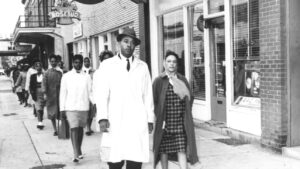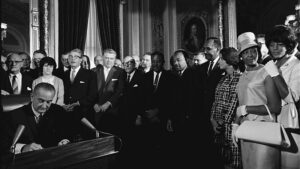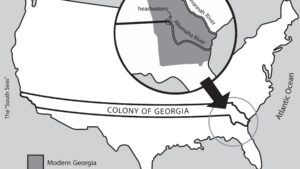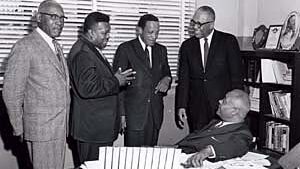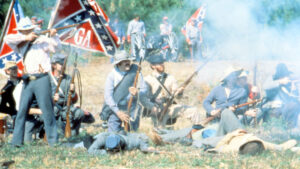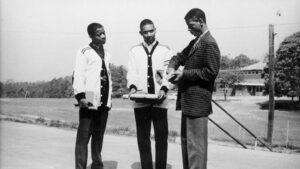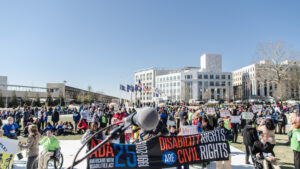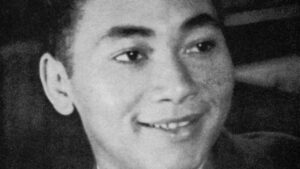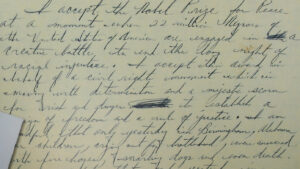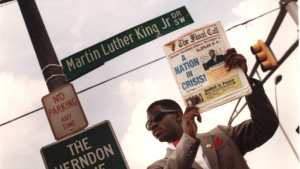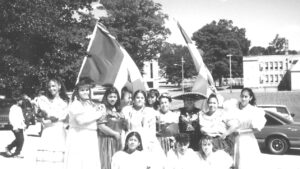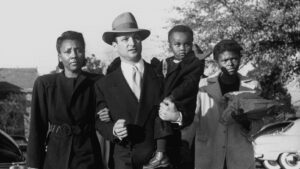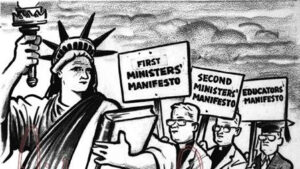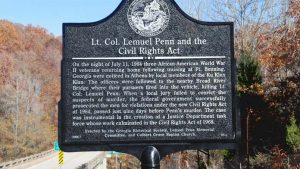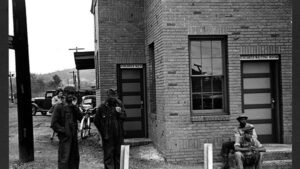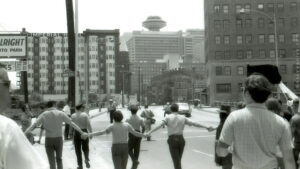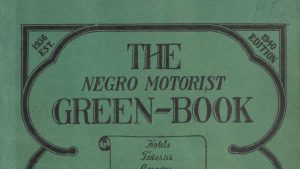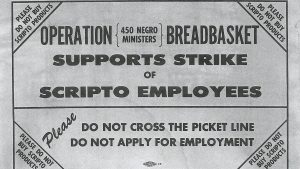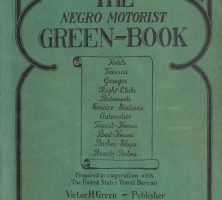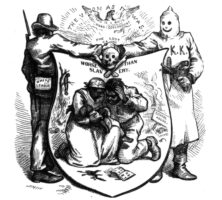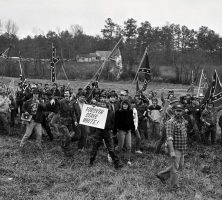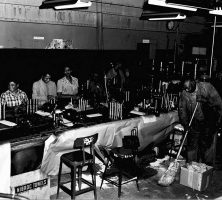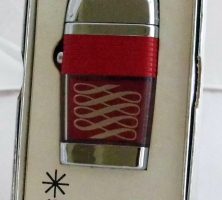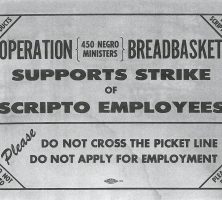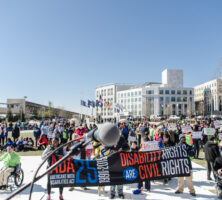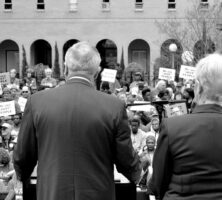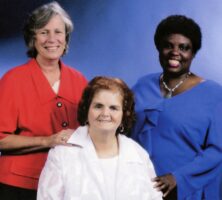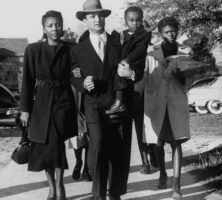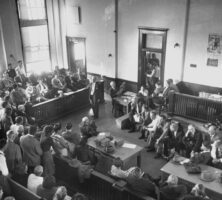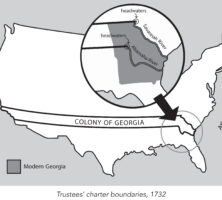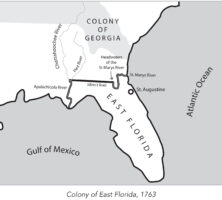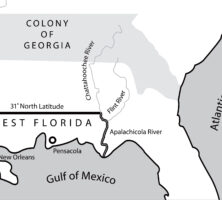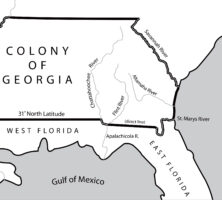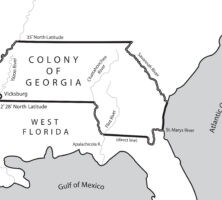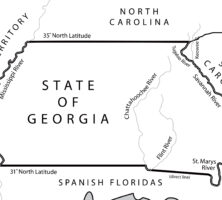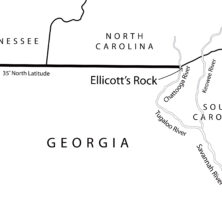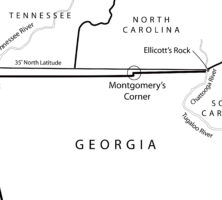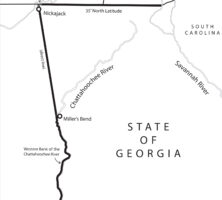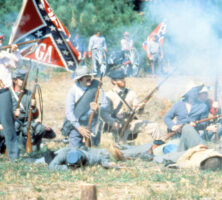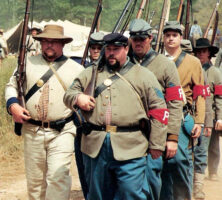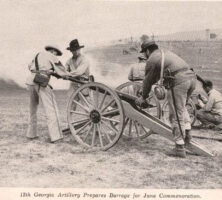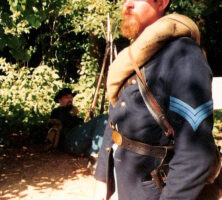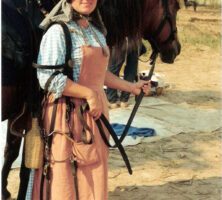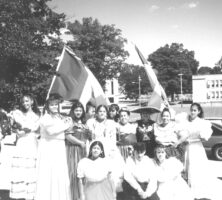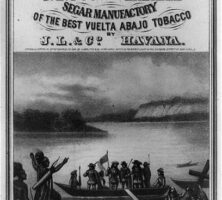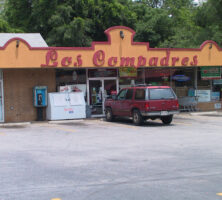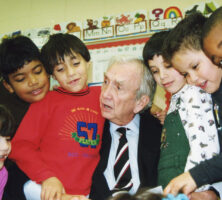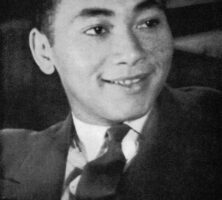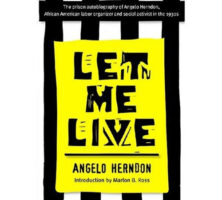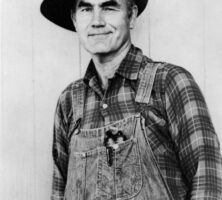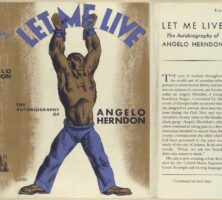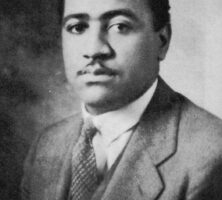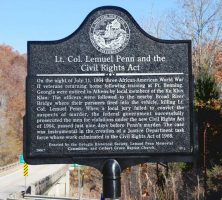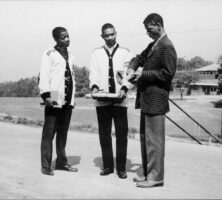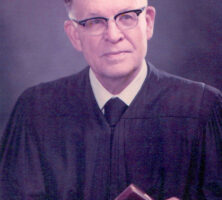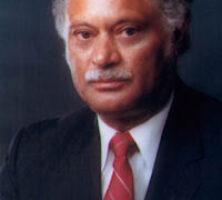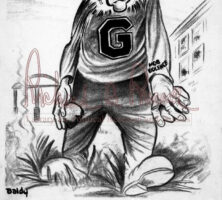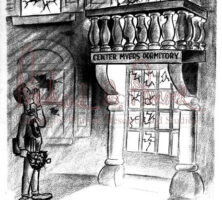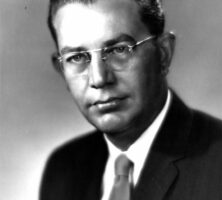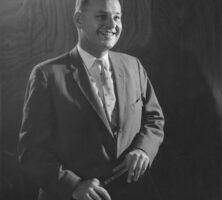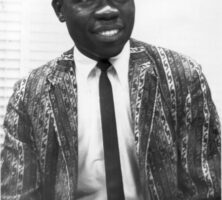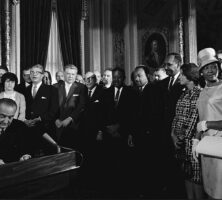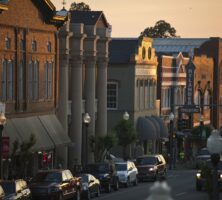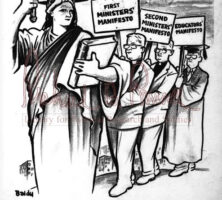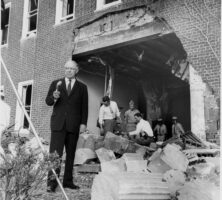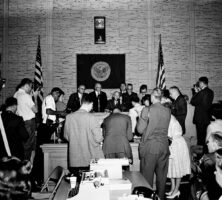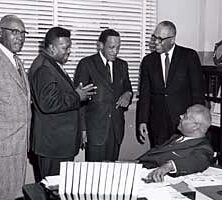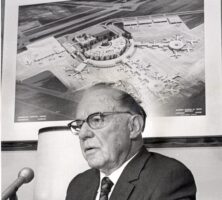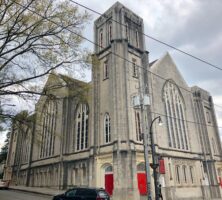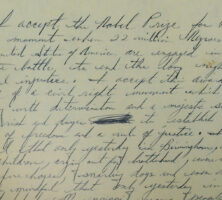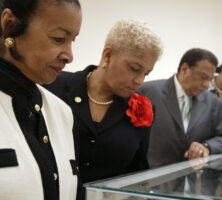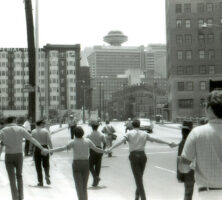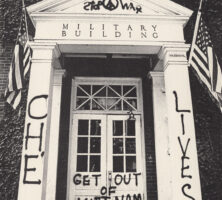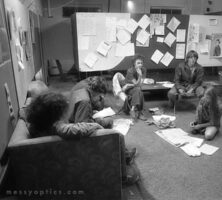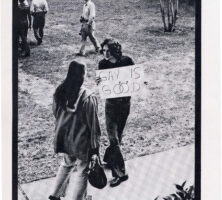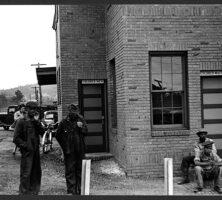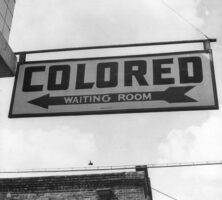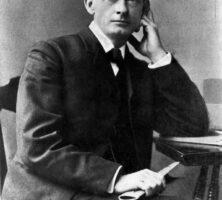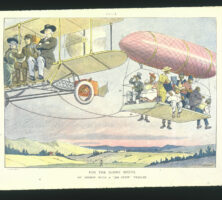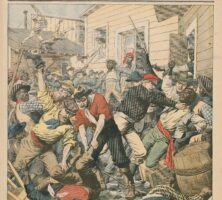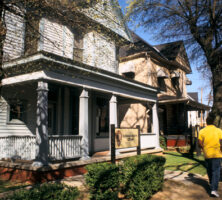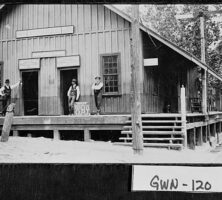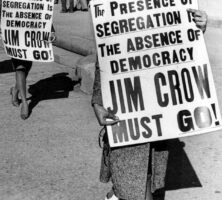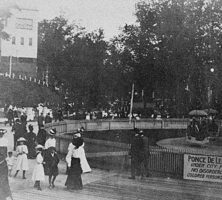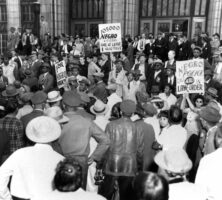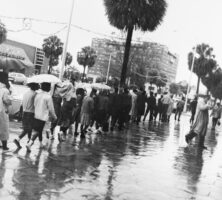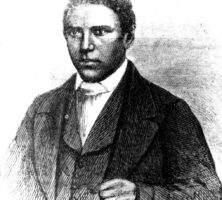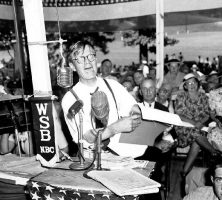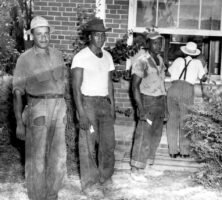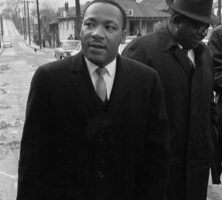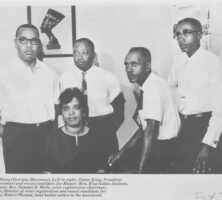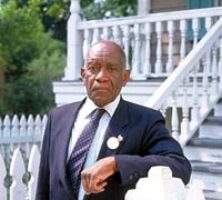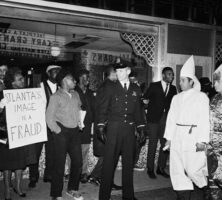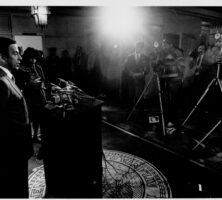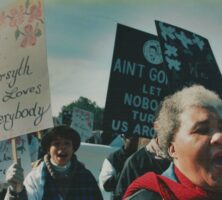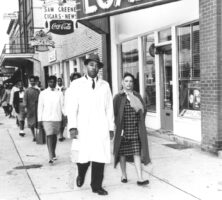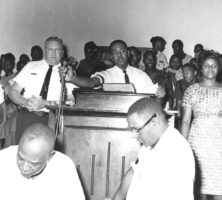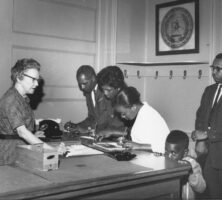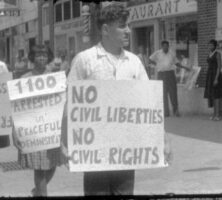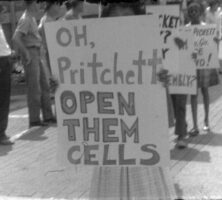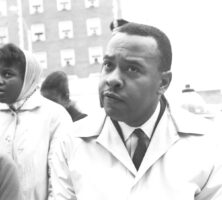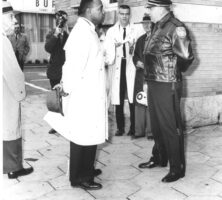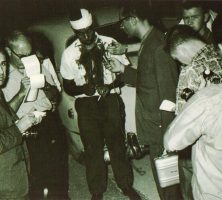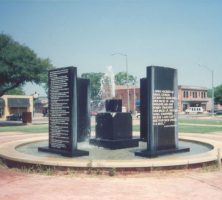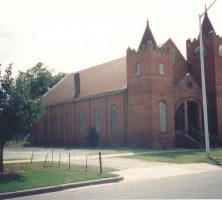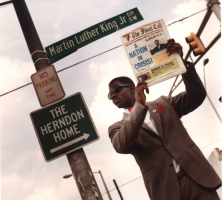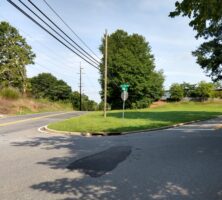The New Georgia Encyclopedia is supported by funding from A More Perfect Union, a special initiative of the National Endowment for the Humanities.
The Negro Motorist Green-Book, also known as the Negro Traveller's Green-Book, was an essential guide for Black travelers between 1936 and 1966. This yearly publication, created by postal employee Victor Hugo Green, helped readers avoid sundown towns and locate safe lodging, gas stops, and eateries.
From Wikimedia
The New Georgia Encyclopedia does not hold the copyright for this media resource and can neither grant nor deny permission to republish or reproduce the image online or in print. All requests for permission to publish or reproduce the resource must be submitted to the rights holder.
Most Ku Klux Klan action was designed to intimidate Black voters and white supporters of the Republican Party. Founded in Tennessee in 1866, the Klan was particularly active in Georgia from 1868 to the early 1870s.
From Harper's Weekly
The New Georgia Encyclopedia does not hold the copyright for this media resource and can neither grant nor deny permission to republish or reproduce the image online or in print. All requests for permission to publish or reproduce the resource must be submitted to the rights holder.
White supremacists picketing at the first Brotherhood March on January 17, 1987, in Forsyth County.
Courtesy of Atlanta Journal-Constitution, Atlanta Journal-Constitution Photographic Archive, #AJCNS1987-01-17l.
The New Georgia Encyclopedia does not hold the copyright for this media resource and can neither grant nor deny permission to republish or reproduce the image online or in print. All requests for permission to publish or reproduce the resource must be submitted to the Atlanta Journal-Constitution.
Between 1931 and 1977, Black female employees at the Scripto factory in Atlanta organized against unfair wages and a discriminatory work environment. Their activism was a precursor to the civil rights movement.
Courtesy of Special Collections & Archives, Georgia State University Library, Lane Brothers Commercial Photographers Photographic Collection, #LBCB095-022a.
The New Georgia Encyclopedia does not hold the copyright for this media resource and can neither grant nor deny permission to republish or reproduce the image online or in print. Requests for permission to publish or reproduce the resource should be submitted to Special Collections and Archives at Georgia State University.
Black women made up more than 80 percent of the workforce at Scripto's factory in Atlanta. This 1958 advertisement depicts ballpoint pens, one of the company's most popular products.
Image from James Vaughan
The New Georgia Encyclopedia does not hold the copyright for this media resource and can neither grant nor deny permission to republish or reproduce the image online or in print. All requests for permission to publish or reproduce the resource must be submitted to the rights holder.
Cigarette lighters, such as the popular Compact Vu-Lighter shown here, were one of Scripto Inc.'s defining products, along with pens and mechanical pencils.
Image from Joe Haupt
The New Georgia Encyclopedia does not hold the copyright for this media resource and can neither grant nor deny permission to republish or reproduce the image online or in print. All requests for permission to publish or reproduce the resource must be submitted to the rights holder.
Operation Breadbasket was created in 1962 as a branch of the Southern Christian Leadership Conference (SCLC). A minister-led program, Operation Breadbasket worked to improve economic conditions in the Black community through boycotts and organized support.
Courtesy of Stuart A. Rose Manuscript, Archives, and Rare Book Library, Emory University, Southern Christian Leadership Records.
The New Georgia Encyclopedia does not hold the copyright for this media resource and can neither grant nor deny permission to republish or reproduce the image online or in print. For more information about this resource, contact the Stuart A. Rose Manuscript, Archives, and Rare Book Library at Emory University.
Crowds gather in Liberty Plaza near the Georgia Capitol for the eighteenth Annual Disability Day on February 18, 2016.
Courtesy of Ryan Johnson
The New Georgia Encyclopedia does not hold the copyright for this media resource and can neither grant nor deny permission to republish or reproduce the image online or in print. All requests for permission to publish or reproduce the resource must be submitted to the rights holder.
Governor Nathan Deal, with First Lady Sandra Deal, addresses the Disability Day crowd on February 20, 2014.
Courtesy of Ryan Johnson
The New Georgia Encyclopedia does not hold the copyright for this media resource and can neither grant nor deny permission to republish or reproduce the image online or in print. All requests for permission to publish or reproduce the resource must be submitted to the rights holder.
From left to right: Sue Jamieson (Atlanta Legal Aid Society) and Olmstead case plaintiffs Elaine Watson and Lois Curtis in 2003.
Photograph used by permission of Institute on Human Development and Disability (UCEDD), College of Family and Consumer Sciences, the University of Georgia
The New Georgia Encyclopedia does not hold the copyright for this media resource and can neither grant nor deny permission to republish or reproduce the image online or in print. All requests for permission to publish or reproduce the resource must be submitted to the rights holder.
Amy Mallard (far left) is pictured in January 1949 outside the Toombs County Courthouse, where she testified at the trial of William Howell, one of several men accused of killing her husband in a racially motivated attack. Mallard was accompainied by Joseph Goldwasser, a member of the NAACP in Cleveland, Ohio, along with her son, John Mallard, and her daughter, Doris Byron.
Courtesy of Getty Images, Francis Miller/The LIFE Picture Collection.
The New Georgia Encyclopedia does not hold the copyright for this media resource and can neither grant nor deny permission to republish or reproduce the image online or in print. All requests for permission to publish or reproduce the resource must be submitted to the rights holder.
A crowd gathered in the Toombs County Courthouse on January 11, 1949, for the trial of William Howell, a white man accused of killing his Black neighbor Robert Mallard. Mallard's wife, Amy, witnessed the murder and testified at the trial, after she was falsely accused of committing the crime herself.
Courtesy of Getty Images, Francis Miller/The LIFE Picture Collection.
The New Georgia Encyclopedia does not hold the copyright for this media resource and can neither grant nor deny permission to republish or reproduce the image online or in print. All requests for permission to publish or reproduce the resource must be submitted to the rights holder.
King George II granted James Oglethorpe and the Trustees a charter in 1732 to establish the colony of Georgia. This charter provided, among other things, that the new colony would consist of all the land between the headwaters of the Savannah and the Altamaha rivers, with its eastern boundary formed by the Atlantic Ocean and its western boundary by the "south seas," a reference to the Pacific Ocean.
Map by John Nelson. Reprinted by permission of William J. Morton
The New Georgia Encyclopedia does not hold the copyright for this media resource and can neither grant nor deny permission to republish or reproduce the image online or in print. All requests for permission to publish or reproduce the resource must be submitted to the rights holder.
In 1763 the British divided what had been Spanish Florida into the two new colonies of West Florida and East Florida, with the Apalachicola River serving as the dividing line between them. East Florida was all the land east of the Apalachicola River, with St. Augustine as its capital.
Map by John Nelson. Reprinted by permission of William J. Morton
The New Georgia Encyclopedia does not hold the copyright for this media resource and can neither grant nor deny permission to republish or reproduce the image online or in print. All requests for permission to publish or reproduce the resource must be submitted to the rights holder.
In 1763 the British divided what had been Spanish Florida into the two new colonies of West Florida and East Florida, with the Apalachicola River serving as the dividing line between them. West Florida, with Pensacola as its capital, extended west to the Mississippi River.
Map by John Nelson. Reprinted by permission of William J. Morton
The New Georgia Encyclopedia does not hold the copyright for this media resource and can neither grant nor deny permission to republish or reproduce the image online or in print. All requests for permission to publish or reproduce the resource must be submitted to the rights holder.
The appointment of James Wright in 1760 as governor of Georgia coincided with a period of expansion. By 1764 the boundaries of the colony had expanded to include those territories between the Mississippi and Chattahoochee rivers that had not been granted to the Florida colonies.
Map by John Nelson. Reprinted by permission of William J. Morton
The New Georgia Encyclopedia does not hold the copyright for this media resource and can neither grant nor deny permission to republish or reproduce the image online or in print. All requests for permission to publish or reproduce the resource must be submitted to the rights holder.
In 1767 the governor of West Florida received permission from the king of England to advance the colony's northern border along the Mississippi and Chattahoochee rivers, where royal trading posts were located. Georgia's land holdings significantly decreased as a result.
Map by John Nelson. Reprinted by permission of William J. Morton
The New Georgia Encyclopedia does not hold the copyright for this media resource and can neither grant nor deny permission to republish or reproduce the image online or in print. All requests for permission to publish or reproduce the resource must be submitted to the rights holder.
The 1783 Treaty of Paris, which ended the Revolutionary War (1775-83), fixed the 31st latitude north as the southern boundary of the new United States. The line extended from the Mississippi River eastward to the Chattahoochee River, moved down that river to its junction with the Flint River, and then followed a direct line east to the headwaters of the St. Marys River.
Map by John Nelson. Reprinted by permission of William J. Morton
The New Georgia Encyclopedia does not hold the copyright for this media resource and can neither grant nor deny permission to republish or reproduce the image online or in print. All requests for permission to publish or reproduce the resource must be submitted to the rights holder.
The Orr-Whitner line was accepted by Florida in 1861 and Georgia in 1866 as their official boundary, although the outbreak of the Civil War (1861-65) delayed the line's approval by the U.S. Congress until 1872.
Map by John Nelson. Reprinted by permission of William J. Morton
The New Georgia Encyclopedia does not hold the copyright for this media resource and can neither grant nor deny permission to republish or reproduce the image online or in print. All requests for permission to publish or reproduce the resource must be submitted to the rights holder.
In 1811 Georgia hired Andrew Ellicott to survey and mark the location of the 35th latitude north, which formed the boundary between Georgia and North Carolina. In an 1812 letter to North Carolina governor William Hawkins, Ellicott states: "In the parallel of 35 degree N. latitude, on the west side of the Chatoga river, a stone is set up marked on the South side (G. lat 35 N.) and on the north side, (N.C.) for North Carolina." This map locates what is currently and erroneously called Ellicott's Rock on the east side of the Chattooga River.
Map by John Nelson. Reprinted by permission of William J. Morton
The New Georgia Encyclopedia does not hold the copyright for this media resource and can neither grant nor deny permission to republish or reproduce the image online or in print. All requests for permission to publish or reproduce the resource must be submitted to the rights holder.
This map shows the surveyed line as marked by James Camak, which set Georgia's northern boundary line south of the 35th latitude north, including the offset known as Montgomery's Corner.
Map by John Nelson. Reprinted by permission of William J. Morton
The New Georgia Encyclopedia does not hold the copyright for this media resource and can neither grant nor deny permission to republish or reproduce the image online or in print. All requests for permission to publish or reproduce the resource must be submitted to the rights holder.
Following the 1802 Article of Agreement and Cession, Georgia's new western boundary began with the juncture of the Chattahoochee and Flint rivers in southwest Georgia and proceeded north to the great bend of the river (at present-day West Point, Georgia). From there it stretched for 160 miles to the Indian village of Nickajack on the Tennessee River and continued from there up to the 35th latitude north.
Map by John Nelson. Reprinted by permission of William J. Morton
The New Georgia Encyclopedia does not hold the copyright for this media resource and can neither grant nor deny permission to republish or reproduce the image online or in print. All requests for permission to publish or reproduce the resource must be submitted to the rights holder.
The Battle of Jonesboro reenactment at Stately Oaks Plantation takes place every second weekend in October.
Courtesy of Clayton County Convention and Visitor's Bureau
The New Georgia Encyclopedia does not hold the copyright for this media resource and can neither grant nor deny permission to republish or reproduce the image online or in print. All requests for permission to publish or reproduce the resource must be submitted to the rights holder.
Reenactors portray a Confederate unit during a reenactment of the Battle of Chickamauga in Walker County in September 1999.
Courtesy of Gordon L. Jones
The New Georgia Encyclopedia does not hold the copyright for this media resource and can neither grant nor deny permission to republish or reproduce the image online or in print. All requests for permission to publish or reproduce the resource must be submitted to the rights holder.
Confederate reenactors crew a half-scale cannon at the Civil War centennial reenactment of the Battle of Kennesaw Mountain in June 1964.
From Centennial Commemoration, Battle of Kennesaw Mountain--June 27, 1864-1964: Official Souvenir Program
The New Georgia Encyclopedia does not hold the copyright for this media resource and can neither grant nor deny permission to republish or reproduce the image online or in print. All requests for permission to publish or reproduce the resource must be submitted to the rights holder.
A reenactor portrays a Union soldier in General William T. Sherman's army at an encampment at the Atlanta History Center in 2005.
Courtesy of Gordon L. Jones
The New Georgia Encyclopedia does not hold the copyright for this media resource and can neither grant nor deny permission to republish or reproduce the image online or in print. All requests for permission to publish or reproduce the resource must be submitted to the rights holder.
A woman portrays a local refugee during a reenactment of the Battle of Chickamauga in Walker County in September 1999.
Courtesy of Gordon L. Jones
The New Georgia Encyclopedia does not hold the copyright for this media resource and can neither grant nor deny permission to republish or reproduce the image online or in print. All requests for permission to publish or reproduce the resource must be submitted to the rights holder.
Latina women from the Mexican, El Salvadoran, and Guatemalan communities in Dalton participate in the city's annual Mexican Independence Day parade.
Courtesy of Thomas Deaton
The New Georgia Encyclopedia does not hold the copyright for this media resource and can neither grant nor deny permission to republish or reproduce the image online or in print. All requests for permission to publish or reproduce the resource must be submitted to the rights holder.
Latino workers plant loblolly pine seedlings in 1999 near Bremen, in Haralson County. Latino immigrants came to Georgia in large numbers during the 1980s and 1990s to work in the agriculture, construction, carpet, and poultry processing industries.
Courtesy of Atlanta Journal-Constitution.
The New Georgia Encyclopedia does not hold the copyright for this media resource and can neither grant nor deny permission to republish or reproduce the image online or in print. All requests for permission to publish or reproduce the resource must be submitted to the Atlanta Journal-Constitution.
An 1866 tobacco label depicts Spanish explorer Hernando de Soto and his crew being welcomed ashore by Native Americans. De Soto entered Georgia twice in 1540, encountering the Altamaha, Capachequi, Coosa, Ichisi, Ocute, Patofa, Toa, and Ulibahali chiefdoms during his travels in the area.
Courtesy of Library of Congress, Prints and Photographs Division
The New Georgia Encyclopedia does not hold the copyright for this media resource and can neither grant nor deny permission to republish or reproduce the image online or in print. All requests for permission to publish or reproduce the resource must be submitted to the rights holder.
The New Georgia Encyclopedia does not hold the copyright for this media resource and can neither grant nor deny permission to republish or reproduce the image online or in print. All requests for permission to publish or reproduce the resource must be submitted to the rights holder.
Centennial Olympic Park, one of the most enduring legacies of the 1996 Olympic Games, was carved out of a blighted area in downtown Atlanta. The twenty-one-acre swath of greenspace and bricks was closed after the games, redesigned for permanent use, then reopened in 1998.
Photograph by Wikimedia
The New Georgia Encyclopedia does not hold the copyright for this media resource and can neither grant nor deny permission to republish or reproduce the image online or in print. All requests for permission to publish or reproduce the resource must be submitted to the rights holder.
Los Compadres, a supermercado (grocery store) located in Athens, is one of many Latino-owned businesses that have opened around the state since the wave of Latino immigration in the 1980s and 1990s.
Photograph by Sarah E. McKee, New Georgia Encyclopedia
The New Georgia Encyclopedia does not hold the copyright for this media resource and can neither grant nor deny permission to republish or reproduce the image online or in print. All requests for permission to publish or reproduce the resource must be submitted to the rights holder.
The New Georgia Encyclopedia does not hold the copyright for this media resource and can neither grant nor deny permission to republish or reproduce the image online or in print. All requests for permission to publish or reproduce the resource must be submitted to the rights holder.
Erwin Mitchell visits elementary students in 2000 at Roan Street School in Dalton. In 1997 Mitchell founded the Georgia Project, an innovative teacher exchange program that provided training opportunities for Dalton educators working in bilingual classrooms until 2007.Reprinted by permission of Christopher Lancette.
The New Georgia Encyclopedia does not hold the copyright for this media resource and can neither grant nor deny permission to republish or reproduce the image online or in print. Requests for permission to publish or reproduce the resource may need to be submitted to the Richard B. Russell Library for Political Research and Studies at the University of Georgia.
The New Georgia Encyclopedia does not hold the copyright for this media resource and can neither grant nor deny permission to republish or reproduce the image online or in print. All requests for permission to publish or reproduce the resource must be submitted to the rights holder.
Angelo Herndon, an Ohio native and member of the Communist Party, became an international figure upon his arrest in 1932, when he was charged with attempting to incite insurrection while organizing workers in Atlanta. His case moved through the Georgia judicial system and appeared twice before the U.S. Supreme Court, which granted Herndon his freedom in 1937.
From Let Me Live, by Angelo Herndon
The New Georgia Encyclopedia does not hold the copyright for this media resource and can neither grant nor deny permission to republish or reproduce the image online or in print. All requests for permission to publish or reproduce the resource must be submitted to the rights holder.
In 2007 the University of Michigan Press reprinted Angelo Herndon's 1937 memoir, Let Me Live, which chronicles his experiences with the Georgia judicial and penal systems during his incarceration as a Communist insurrectionist from 1932 to 1937.
The New Georgia Encyclopedia does not hold the copyright for this media resource and can neither grant nor deny permission to republish or reproduce the image online or in print. All requests for permission to publish or reproduce the resource must be submitted to the rights holder.
Georgia native and poet Don West briefly headed the Provisional Committee for the Defense of Angelo Herndon, an organization dedicated to exonerating Herndon, who was arrested as a Communist insurrectionist in Atlanta in 1932.
From In a Land of Plenty, by Don West
The New Georgia Encyclopedia does not hold the copyright for this media resource and can neither grant nor deny permission to republish or reproduce the image online or in print. All requests for permission to publish or reproduce the resource must be submitted to the rights holder.
Angelo Herndon, arrested in 1932 as a Communist insurrectionist while organizing workers in Atlanta, spent five years in the Georgia penal system before the U.S. Supreme Court granted his freedom in 1937. Herndon chronicled his experiences in Let Me Live, which was published by Random House in 1937.
The New Georgia Encyclopedia does not hold the copyright for this media resource and can neither grant nor deny permission to republish or reproduce the image online or in print. All requests for permission to publish or reproduce the resource must be submitted to the rights holder.
The New Georgia Encyclopedia does not hold the copyright for this media resource and can neither grant nor deny permission to republish or reproduce the image online or in print. All requests for permission to publish or reproduce the resource must be submitted to the rights holder.
Benjamin J. Davis Jr., along with John H. Geer, served as the attorney contracted by the International Labor Defense party to defend Angelo Herndon. Herndon, arrested as a Communist insurrectionist in 1932, was acquitted in 1937.
From Let Me Live, by Angelo Herndon
The New Georgia Encyclopedia does not hold the copyright for this media resource and can neither grant nor deny permission to republish or reproduce the image online or in print. All requests for permission to publish or reproduce the resource must be submitted to the rights holder.
A historical marker on Georgia Highway 172 in Madison County commemorates the murder of Lt. Col. Lemuel Penn by Ku Klux Klan members in 1964.
Courtesy of Georgia Info, Digital Library of Georgia.
The New Georgia Encyclopedia does not hold the copyright for this media resource and can neither grant nor deny permission to republish or reproduce the image online or in print. Requests for permission to publish or reproduce the resource may need to be submitted to the Digital Library of Georgia.
Students Ford Greene, Lawrence Michael Williams, and Ralph Long Jr. (left to right) integrated the Georgia Institute of Technology in 1961. Georgia Tech was the first institution of higher education in the South to integrate peacefully and without a court order.
The New Georgia Encyclopedia does not hold the copyright for this media resource and can neither grant nor deny permission to republish or reproduce the image online or in print. Requests for permission to publish or reproduce the resource should be submitted to the Georgia Institute of Technology Library and Information Center.
William Bootle served as a U.S. District Court judge in Georgia from 1954 to 1981. His rulings upheld decisions made by the U.S. Supreme Court in matters of school desegregation, including the desegregation of the University of Georgia in 1961.
Courtesy of Macon District Court
The New Georgia Encyclopedia does not hold the copyright for this media resource and can neither grant nor deny permission to republish or reproduce the image online or in print. All requests for permission to publish or reproduce the resource must be submitted to the rights holder.
In 1950 Horace T. Ward became the first African American to challenge the racially discriminatory practices at the University of Georgia. Although Ward's efforts were not successful, his case helped to lay the groundwork for desegregation of the university.
Courtesy of UGA Photographic Services
The New Georgia Encyclopedia does not hold the copyright for this media resource and can neither grant nor deny permission to republish or reproduce the image online or in print. All requests for permission to publish or reproduce the resource must be submitted to the rights holder.
The New Georgia Encyclopedia does not hold the copyright for this media resource and can neither grant nor deny permission to republish or reproduce the image online or in print. All requests for permission to publish or reproduce the resource must be submitted to the rights holder.
This cartoon by Clifford "Baldy" Baldowski depicts Frankenstein wearing a University of Georgia shirt labeled "Mob Violence." Published in 1961 in the Atlanta Constitution, the drawing refers to the riots that took place on campus in response to the desegregation of the university.
Courtesy of Richard B. Russell Library for Political Research and Studies, University of Georgia Libraries, Clifford Baldowski Editorial Cartoon Collection.
The New Georgia Encyclopedia does not hold the copyright for this media resource and can neither grant nor deny permission to republish or reproduce the image online or in print. Requests for permission to publish or reproduce the resource may need to be submitted to the Richard B. Russell Library for Political Research and Studies at the University of Georgia.
A 1961 cartoon by Clifford "Baldy" Baldowski comments on the riots at the University of Georgia, which occurred in response to the admission of two Black students, Charlayne Hunter and Hamilton Holmes. The cartoon depicts Hunter saying, "Jeepers. I don't know if he's the same as he use to be or not!"
Courtesy of Richard B. Russell Library for Political Research and Studies, University of Georgia Libraries, Clifford Baldowski Editorial Cartoon Collection.
The New Georgia Encyclopedia does not hold the copyright for this media resource and can neither grant nor deny permission to republish or reproduce the image online or in print. Requests for permission to publish or reproduce the resource may need to be submitted to the Richard B. Russell Library for Political Research and Studies at the University of Georgia.
Under Ernest Vandiver's governorship, from 1959 to 1963, the legislature implemented sweeping changes in the segregation policies of Georgia's public schools. The county unit system for nominating officeholders was also revised during his tenure.
The New Georgia Encyclopedia does not hold the copyright for this media resource and can neither grant nor deny permission to republish or reproduce the image online or in print. Requests for permission to publish or reproduce the resource should be submitted to the Hargrett Manuscript and Rare Book Library at the University of Georgia.
In the aftermath of riots following the integration of the University of Georgia, Edwin Harrison, president of the Georgia Institute of Technology, allowed the admission of Black students in May 1961. Georgia Tech became the first institution of higher education in the South to integrate peacefully and without a court order.
The New Georgia Encyclopedia does not hold the copyright for this media resource and can neither grant nor deny permission to republish or reproduce the image online or in print. Requests for permission to publish or reproduce the resource should be submitted to the Georgia Institute of Technology Library and Information Center.
In 1963 Mercer University in Macon became integrated when it granted admission to Sam Oni, an applicant from the West African country of Ghana.
Courtesy of Mercer University
The New Georgia Encyclopedia does not hold the copyright for this media resource and can neither grant nor deny permission to republish or reproduce the image online or in print. All requests for permission to publish or reproduce the resource must be submitted to the rights holder.
U.S. president Lyndon B. Johnson signs the Voting Rights Act into law on August 6, 1965, as a crowd, including Martin Luther King, looks on. The law prohibited racial discrimination in voting procedures. Today Georgia voters must be eighteen years of age and legal residents of a state county.
Photograph by Wikimedia
The New Georgia Encyclopedia does not hold the copyright for this media resource and can neither grant nor deny permission to republish or reproduce the image online or in print. All requests for permission to publish or reproduce the resource must be submitted to the rights holder.
The Americus Movement (1963-65) began in Americus, in southwest Georgia, when less than a dozen activists protested against the segregated Martin Theater. The well-organized movement soon grew to number in the hundreds.
Courtesy of Explore Georgia, Photograph by Ralph Daniel.
The New Georgia Encyclopedia does not hold the copyright for this media resource and can neither grant nor deny permission to republish or reproduce the image online or in print. Requests for permission to publish or reproduce the resource may need to be submitted to Explore Georgia.
This cartoon, by well-known political cartoonist Clifford "Baldy" Baldowski, refers to the Ministers' Manifesto, a statement issued by the Atlanta Christian Council in 1957 to urge the peaceful integration of public schools. A second manifesto, encouraging racial moderation, was issued in the wake of the Temple bombing in 1958. The cartoon, published in 1960, appeared in the Atlanta Constitution.
Courtesy of Richard B. Russell Library for Political Research and Studies, University of Georgia Libraries, Clifford Baldowski Editorial Cartoon Collection.
The New Georgia Encyclopedia does not hold the copyright for this media resource and can neither grant nor deny permission to republish or reproduce the image online or in print. Requests for permission to publish or reproduce the resource may need to be submitted to the Richard B. Russell Library for Political Research and Studies at the University of Georgia.
Atlanta mayor William B. Hartsfield speaks about the bombing of "the Temple" in Atlanta on October 13, 1958, the day after a dynamite blast destroyed portions of the Hebrew Benevolent Congregation's synagogue. Hartsfield denounced the act, accusing the bombers of giving "a bad name to the South."
Courtesy of Atlanta Journal-Constitution.
The New Georgia Encyclopedia does not hold the copyright for this media resource and can neither grant nor deny permission to republish or reproduce the image online or in print. All requests for permission to publish or reproduce the resource must be submitted to the Atlanta Journal-Constitution.
Reporters gather at Atlanta's city hall on August 30, 1961, the day that the city's schools were officially integrated. The recommendations of the Sibley Commission to the state legislature in 1960 contributed to the desegregation of schools across Georgia.
Courtesy of Special Collections & Archives, Georgia State University Library, Lane Brothers Commercial Photographers Photographic Collection.
The New Georgia Encyclopedia does not hold the copyright for this media resource and can neither grant nor deny permission to republish or reproduce the image online or in print. Requests for permission to publish or reproduce the resource should be submitted to Special Collections and Archives at Georgia State University.
Leaders of the movement to desegregate the bus system in Atlanta gather in the office of Rev. William Holmes Borders (seated) at Wheat Street Baptist Church. From left, Rev. R. B. Shorts, Rev. R. Joseph Johnson, Rev. Howard T. Bussey, and Rev. Ray Williams.
Courtesy of Wheat Street Baptist Church; Estate of the Reverend William Holmes Borders Sr.
The New Georgia Encyclopedia does not hold the copyright for this media resource and can neither grant nor deny permission to republish or reproduce the image online or in print. All requests for permission to publish or reproduce the resource must be submitted to the rights holder.
As mayor, Hartsfield guided Atlanta through World War II with a policy of fiscal restraint. He also led the city through the racial unrest of the civil rights movement in the 1950s and 1960s, overseeing the peaceful integration of the city's bus system in 1957 and schools in 1961.
Courtesy of Stuart A. Rose Manuscript, Archives, and Rare Book Library, Emory University, William Berry Hartsfield Papers.
The New Georgia Encyclopedia does not hold the copyright for this media resource and can neither grant nor deny permission to republish or reproduce the image online or in print. For more information about this resource, contact the Stuart A. Rose Manuscript, Archives, and Rare Book Library at Emory University.
The planning of the "Love, Law, and Liberation" movement, which integrated the Atlanta bus system, took place at Wheat Street Baptist Church, on Sweet Auburn Avenue. The movement, which began in January 1957, was led by the church's pastor, William Holmes Borders.
Photograph by Warren LeMay
The New Georgia Encyclopedia does not hold the copyright for this media resource and can neither grant nor deny permission to republish or reproduce the image online or in print. All requests for permission to publish or reproduce the resource must be submitted to the rights holder.
A handwritten copy of Martin Luther King Jr.'s acceptance speech for the Nobel Peace Prize is included in the Morehouse College Martin Luther King Jr. Collection. King delivered the speech in Oslo, Norway, in 1964.
Courtesy of Atlanta Journal-Constitution.
The New Georgia Encyclopedia does not hold the copyright for this media resource and can neither grant nor deny permission to republish or reproduce the image online or in print. All requests for permission to publish or reproduce the resource must be submitted to the Atlanta Journal-Constitution.
Atlanta mayor Shirley Franklin (second from left) examines a display of Martin Luther King Jr.'s papers at Sotheby's auction house in New York City. Franklin led the effort in 2006 to raise $32 million to purchase the papers for Atlanta. Also pictured, from left, Xernona Clayton, Andrew Young, and Carolyn Young.
Courtesy of Atlanta Journal-Constitution.
The New Georgia Encyclopedia does not hold the copyright for this media resource and can neither grant nor deny permission to republish or reproduce the image online or in print. All requests for permission to publish or reproduce the resource must be submitted to the Atlanta Journal-Constitution.
In 1970 demonstrators in downtown Atlanta protest U.S. involvement in the Vietnam War (1964-73). Most antiwar marches in the city, which took place from the late 1960s to the early 1970s, followed a route down Peachtree Street to Piedmont Park.
Photograph by Carter Tomassi
The New Georgia Encyclopedia does not hold the copyright for this media resource and can neither grant nor deny permission to republish or reproduce the image online or in print. All requests for permission to publish or reproduce the resource must be submitted to the rights holder.
Graffiti left by antiwar protestors marks the military building at the University of Georgia in Athens during the Vietnam War (1964-73). Student activists at UGA attempted to burn down the building five times between 1968 and 1972. The slogan "Che Lives" is a reference to Che Guevara, a leader of the socialist revolution in Cuba and an icon of the American New Left. He was captured and executed in Bolivia in 1967.
The New Georgia Encyclopedia does not hold the copyright for this media resource and can neither grant nor deny permission to republish or reproduce the image online or in print. Requests for permission to publish or reproduce the resource should be submitted to the Hargrett Manuscript and Rare Book Library at the University of Georgia.
Staff members of the Great Speckled Bird, an underground newspaper in Atlanta published from 1968 to 1976, meet to plan a forthcoming issue. The paper, founded by students from several Georgia colleges, advocated New Left issues.
Photograph by Carter Tomassi
The New Georgia Encyclopedia does not hold the copyright for this media resource and can neither grant nor deny permission to republish or reproduce the image online or in print. All requests for permission to publish or reproduce the resource must be submitted to the rights holder.
A student demonstrates for gay rights at the University of Georgia in Athens, circa 1971. In 1972 the Committee on Gay Education at the university successfully sued for the right to hold a dance on campus.
The New Georgia Encyclopedia does not hold the copyright for this media resource and can neither grant nor deny permission to republish or reproduce the image online or in print. Requests for permission to publish or reproduce the resource should be submitted to the Hargrett Manuscript and Rare Book Library at the University of Georgia.
Signs above the doors at a railroad station in Manchester (Meriwether County), pictured in 1944, read "Colored Men" and "Colored Waiting Room," indicating segregated facilities.
Courtesy of Library of Congress, Prints and Photographs Division, Farm Security Administration - Office of War Information Photograph Collection, #LC-USF3301-001172-M4.
The New Georgia Encyclopedia does not hold the copyright for this media resource and can neither grant nor deny permission to republish or reproduce the image online or in print. All requests for permission to publish or reproduce the resource must be submitted to the rights holder.
A sign, pictured in 1943, indicates separate facilities for Black customers at a bus station in Rome. Segregation of Blacks and whites became a common occurence in the South with the rise of Jim Crow laws in the 1890s.
Photograph by Wikimedia
The New Georgia Encyclopedia does not hold the copyright for this media resource and can neither grant nor deny permission to republish or reproduce the image online or in print. All requests for permission to publish or reproduce the resource must be submitted to the rights holder.
The New Georgia Encyclopedia does not hold the copyright for this media resource and can neither grant nor deny permission to republish or reproduce the image online or in print. All requests for permission to publish or reproduce the resource must be submitted to the rights holder.
In 1892 Georgia politics was shaken by the arrival of the Populist Party. Led by Thomas E. Watson of McDuffie County, this new party mainly appealed to white farmers, many of whom had been impoverished by debt and low cotton prices in the 1880s and 1890s. The Populists also attempted to win the support of Black farmers away from the Republican Party.
Courtesy of Georgia Historical Society.
The New Georgia Encyclopedia does not hold the copyright for this media resource and can neither grant nor deny permission to republish or reproduce the image online or in print. All requests for permission to publish or reproduce the resource must be submitted to Georgia Historical Society.
A caricature entitled "For the Sunny South," published in 1913, depicts an airplane towing a "Jim Crow trailer."
Courtesy of Library of Congress, Prints and Photographs Division
The New Georgia Encyclopedia does not hold the copyright for this media resource and can neither grant nor deny permission to republish or reproduce the image online or in print. All requests for permission to publish or reproduce the resource must be submitted to the rights holder.
The race massacre of 1906 made international headlines and threatened Atlanta's image as a thriving New South city. The incident, sparked by sensationalized accounts of Black violence, lasted for two nights and resulted in dozens of Black deaths. It was reported in the October 7, 1906, issue of the French publication Le Petit Journal. The original caption translates as "Lynchings in the United States."
The New Georgia Encyclopedia does not hold the copyright for this media resource and can neither grant nor deny permission to republish or reproduce the image online or in print. All requests for permission to publish or reproduce the resource must be submitted to the rights holder.
The Sweet Auburn neighborhood was the heart of the Black residential and business community in the first part of the twentieth century. Pictured in the foreground is an administrative office of the National Park Service, which maintains the Martin Luther King Jr. National Historic Site in the neighborhood.
Courtesy of Georgia Department of Economic Development.
The New Georgia Encyclopedia does not hold the copyright for this media resource and can neither grant nor deny permission to republish or reproduce the image online or in print. Requests for permission to publish or reproduce the resource may need to be submitted to the Georgia Department of Economic Development.
A postcard depicts passengers waiting outside a segregated train depot in Suwanee (Gwinnett County), circa 1915.
Courtesy of Georgia Archives, Vanishing Georgia, #
gwn120.
The New Georgia Encyclopedia does not hold the copyright for this media resource and can neither grant nor deny permission to republish or reproduce the image online or in print. Requests for permission to publish or reproduce the resource should be submitted to the Georgia Archives.
Students protest segregation at the state capitol building in Atlanta on February 1, 1962. The passage of the federal Civil Rights Act in 1964 and the Voting Rights Act in 1965 ended legal segregation across the nation.
Courtesy of Atlanta Journal-Constitution.
The New Georgia Encyclopedia does not hold the copyright for this media resource and can neither grant nor deny permission to republish or reproduce the image online or in print. All requests for permission to publish or reproduce the resource must be submitted to the Atlanta Journal-Constitution.
By the 1880s, as Atlanta grew and expanded, so too did Jim Crow segregation. The popular Ponce de Leon Springs, an amusement park and lake, was for whites only. Blacks were permitted only as servants.
Courtesy of Georgia Archives, Vanishing Georgia, #
ful0356.
The New Georgia Encyclopedia does not hold the copyright for this media resource and can neither grant nor deny permission to republish or reproduce the image online or in print. Requests for permission to publish or reproduce the resource should be submitted to the Georgia Archives.
In 1947 demonstrators gather in Atlanta to demand the desegregation of the Atlanta police force. The signs read: "For Negro Police"; "105,000 Negro Citizens Rate at Least 1 Negro Police"; and "Negro Police Will Aid in Law & Order."
Courtesy of Atlanta Journal-Constitution.
The New Georgia Encyclopedia does not hold the copyright for this media resource and can neither grant nor deny permission to republish or reproduce the image online or in print. All requests for permission to publish or reproduce the resource must be submitted to the Atlanta Journal-Constitution.
Protesters march down Broad Street in Albany during the Albany Movement, one of the largest civil rights campaigns in Georgia. From 1961 to 1962 Black residents protested the city's segregationist practices. Around 1,200 protesters were imprisoned as a result of their activities during the movement.
Courtesy of Georgia Archives, Vanishing Georgia, #dgh231-86.
The New Georgia Encyclopedia does not hold the copyright for this media resource and can neither grant nor deny permission to republish or reproduce the image online or in print. Requests for permission to publish or reproduce the resource should be submitted to the Georgia Archives.
One of the most influential African American leaders in late-nineteenth-century Georgia, Henry McNeal Turner was a pioneering church organizer and missionary for the African Methodist Episcopal Church (A.M.E.) in Georgia.
Courtesy of Georgia Historical Society.
The New Georgia Encyclopedia does not hold the copyright for this media resource and can neither grant nor deny permission to republish or reproduce the image online or in print. All requests for permission to publish or reproduce the resource must be submitted to Georgia Historical Society.
Georgia governor Eugene Talmadge speaks at a 1942 political rally in Moultrie. During his 1946 gubernatorial campaign, Talmadge ran on a white supremacist platform and won a fourth term as governor in an election widely considered to be fraudulent. He died before he could take office, however, and the state legislature selected his son, Herman Talmadge, to assume the governorship.
Courtesy of Special Collections & Archives, Georgia State University Library, Lane Brothers Commercial Photographers Photographic Collection.
The New Georgia Encyclopedia does not hold the copyright for this media resource and can neither grant nor deny permission to republish or reproduce the image online or in print. Requests for permission to publish or reproduce the resource should be submitted to Special Collections and Archives at Georgia State University.
African Americans in Milledgeville wait in line to vote following the Civil Rights Act of 1957. The act created both the Civil Rights Division of the Justice Department and a commission to investigate racial or religious discrimination during voter registrations and elections.
The New Georgia Encyclopedia does not hold the copyright for this media resource and can neither grant nor deny permission to republish or reproduce the image online or in print. Requests for permission to publish or reproduce the resource may need to be submitted to the Richard B. Russell Library for Political Research and Studies at the University of Georgia.
King's interest in nonviolence became a central tenet of his leadership of the Southern Christian Leadership Conference and helped lead a young generation of African Americans to promote desegregation through peaceful sit-ins.
Courtesy of Atlanta History Center.
The New Georgia Encyclopedia does not hold the copyright for this media resource and can neither grant nor deny permission to republish or reproduce the image online or in print. Requests for permission to publish or reproduce the resource should be submitted to the Atlanta History Center.
The Albany Movement leaders included, from left, Slater King, the president of the movement; Elza Goldie Jackson, the recording secretary; the Reverend Sammie B. Wells, the chairman of voter registration; Thomas Chatmon, the director of voter registration; and Robert Thomas, a local barber and active volunteer.
Reprinted from Freedomways
The New Georgia Encyclopedia does not hold the copyright for this media resource and can neither grant nor deny permission to republish or reproduce the image online or in print. All requests for permission to publish or reproduce the resource must be submitted to the rights holder.
W. W. Law, known as "Mr. Civil Rights," served as president of the Savannah NAACP from 1950 to 1976. During his tenure he led protests and boycotts against segregated businesses in the city and was fired from his job with the U.S. Postal Service for his civil rights activities. His job was restored to him as a result of U.S. president John F. Kennedy's intervention.
Courtesy of Georgia Department of Economic Development.
The New Georgia Encyclopedia does not hold the copyright for this media resource and can neither grant nor deny permission to republish or reproduce the image online or in print. Requests for permission to publish or reproduce the resource may need to be submitted to the Georgia Department of Economic Development.
Although Atlanta claimed to be "a city too busy to hate," racial animosity is evident in this 1964 photograph documenting simultaneous protests. The Ku Klux Klan, marching to protest the desegregation of an Atlanta hotel, passes by a group of African Americans demonstrating against a segregated restaurant.
Photograph from Corbis
The New Georgia Encyclopedia does not hold the copyright for this media resource and can neither grant nor deny permission to republish or reproduce the image online or in print. All requests for permission to publish or reproduce the resource must be submitted to the rights holder.
The New Georgia Encyclopedia does not hold the copyright for this media resource and can neither grant nor deny permission to republish or reproduce the image online or in print. All requests for permission to publish or reproduce the resource must be submitted to the rights holder.
Andrew Young was elected to the U.S. Senate in 1972 and as mayor of Atlanta in 1981. His elections signaled the institutionalization of the revolution in Black political power he had helped to create in Georgia. Young won the mayoral reelection in 1985 but was defeated in a 1990 primary bid to become the Democratic candidate for governor of Georgia.
Courtesy of Special Collections & Archives, Georgia State University Library, Atlanta Journal-Constitution Photographic Archive.
The New Georgia Encyclopedia does not hold the copyright for this media resource and can neither grant nor deny permission to republish or reproduce the image online or in print. Requests for permission to publish or reproduce the resource should be submitted to Special Collections and Archives at Georgia State University.
Marchers demonstrate for fair housing in Forsyth County in 1987. The march, led by Hosea Williams, ended in a confrontation with Ku Klux Klansmen throwing rocks and bottles at the demonstrators. The incident brought national attention to Forsyth County and resulted in the indictment of two Klan organizations.
Courtesy of Atlanta Journal-Constitution.
The New Georgia Encyclopedia does not hold the copyright for this media resource and can neither grant nor deny permission to republish or reproduce the image online or in print. All requests for permission to publish or reproduce the resource must be submitted to the Atlanta Journal-Constitution.
Slater King and Irene Asbury Wright lead a group of protestors in Albany. Wright, dean of students at Albany State College, resigned in protest on hearing that Albany State students had been expelled for participating in demonstrations.
Courtesy of Cochran Studios/A. E. Jenkins Photography
The New Georgia Encyclopedia does not hold the copyright for this media resource and can neither grant nor deny permission to republish or reproduce the image online or in print. All requests for permission to publish or reproduce the resource must be submitted to the rights holder.
The New Georgia Encyclopedia does not hold the copyright for this media resource and can neither grant nor deny permission to republish or reproduce the image online or in print. All requests for permission to publish or reproduce the resource must be submitted to the rights holder.
Albany police chief Laurie Pritchett (center left) with civil rights activist Slater King (center right) in Shiloh Baptist Church, where Student Nonviolent Coordinating Committee members first met.
Courtesy of Cochran Studios/A. E. Jenkins Photography
The New Georgia Encyclopedia does not hold the copyright for this media resource and can neither grant nor deny permission to republish or reproduce the image online or in print. All requests for permission to publish or reproduce the resource must be submitted to the rights holder.
(Left to right) Thomas Chatmon, Marion King, and an unidentified woman register to vote, to the apparent dismay of the office worker. They are accompanied by young Jonathon King and Slater King (far right).
Courtesy of Cochran Studios/A. E. Jenkins Photography
The New Georgia Encyclopedia does not hold the copyright for this media resource and can neither grant nor deny permission to republish or reproduce the image online or in print. All requests for permission to publish or reproduce the resource must be submitted to the rights holder.
Protestors march in Albany during the Albany Movement, an effort to desegregate the city that lasted from fall 1961 to summer 1962.
The New Georgia Encyclopedia does not hold the copyright for this media resource and can neither grant nor deny permission to republish or reproduce the image online or in print. All requests for permission to publish or reproduce the resource must be submitted to the Walter J. Brown Media Archives and Peabody Awards Collection.
Demonstrators protest the imprisonment of fellow protestors by Albany police sheriff Laurie Pritchett during the Albany Movement, a collaborative effort by such civil rights groups as SNCC, the SCLC, and the NAACP to desegregate the city of Albany in 1961-62.
Courtesy of Walter J. Brown Media Archives and Peabody Awards Collection, University of Georgia Libraries, WSB Television Newsfilm Collection.
The New Georgia Encyclopedia does not hold the copyright for this media resource and can neither grant nor deny permission to republish or reproduce the image online or in print. All requests for permission to publish or reproduce the resource must be submitted to the Walter J. Brown Media Archives and Peabody Awards Collection.
(Left to right) Attorney T. M. Jackson, chief counsel Donald Hollowell, Dr. William G. Anderson, and attorney C. B. King stand in front of the Albany federal courthouse and post office.
Courtesy of Cochran Studios/A. E. Jenkins Photography
The New Georgia Encyclopedia does not hold the copyright for this media resource and can neither grant nor deny permission to republish or reproduce the image online or in print. All requests for permission to publish or reproduce the resource must be submitted to the rights holder.
Civil rights activist and real estate broker Slater King was one of the leaders of the Albany Movement. To the left is Bernice Johnson, one of the original Student Nonviolent Coordinating Committee Freedom Singers, who later formed the musical group Sweet Honey in the Rock.
Courtesy of Cochran Studios/A. E. Jenkins Photography
The New Georgia Encyclopedia does not hold the copyright for this media resource and can neither grant nor deny permission to republish or reproduce the image online or in print. All requests for permission to publish or reproduce the resource must be submitted to the rights holder.
Civil rights activist Slater King confronts Albany police chief Laurie Pritchett.
Courtesy of Cochran Studios/A. E. Jenkins Photography
The New Georgia Encyclopedia does not hold the copyright for this media resource and can neither grant nor deny permission to republish or reproduce the image online or in print. All requests for permission to publish or reproduce the resource must be submitted to the rights holder.
An injured C. B. King, in 1962, talks to reporters after being caned by Dougherty County sheriff Cull Campbell in the sheriff's office. King had visited the county jail to check on an injured white demonstrator, William Hansen. Hansen's jaw had been broken in a beating he received when he was put in a cell with other white prisoners who objected to the civil rights protests.
Courtesy of Cochran Studios/A. E. Jenkins Photography
The New Georgia Encyclopedia does not hold the copyright for this media resource and can neither grant nor deny permission to republish or reproduce the image online or in print. All requests for permission to publish or reproduce the resource must be submitted to the rights holder.
The Albany Civil Rights Memorial is located in the the city's Charles Sherrod Civil Rights Park. Sherrod came to Albany in 1961 with the Student Nonviolent Coordinating Committee to organize a voter registration drive.
The New Georgia Encyclopedia does not hold the copyright for this media resource and can neither grant nor deny permission to republish or reproduce the image online or in print. All requests for permission to publish or reproduce the resource must be submitted to the rights holder.
The Albany Civil Rights Movement Museum (later the Albany Civil Rights Institute) opened in 1998 in the former Old Mt. Zion Church. In 1961 Martin Luther King Jr. organized a mass meeting of civil rights activists, which met at the church. The museum moved to a new facility adjacent to Old Mt. Zion in 2008.
The New Georgia Encyclopedia does not hold the copyright for this media resource and can neither grant nor deny permission to republish or reproduce the image online or in print. All requests for permission to publish or reproduce the resource must be submitted to the rights holder.
Streets named after Martin Luther King Jr. are common and controversial landscape features. Found in towns and cities across the country, these streets are most prevalent in Georgia.
Courtesy of Special Collections & Archives, Georgia State University Library, Atlanta Journal-Constitution Photographic Archive.
The New Georgia Encyclopedia does not hold the copyright for this media resource and can neither grant nor deny permission to republish or reproduce the image online or in print. Requests for permission to publish or reproduce the resource should be submitted to Special Collections and Archives at Georgia State University.
The New Georgia Encyclopedia does not hold the copyright for this media resource and can neither grant nor deny permission to republish or reproduce the image online or in print. All requests for permission to publish or reproduce the resource must be submitted to the rights holder.
The intersection of Ruth Drive and Martin Luther King Jr. Parkway in Athens.
Photograph by Katie Korth
The New Georgia Encyclopedia does not hold the copyright for this media resource and can neither grant nor deny permission to republish or reproduce the image online or in print. All requests for permission to publish or reproduce the resource must be submitted to the rights holder.
The New Georgia Encyclopedia does not hold the copyright for this media resource and can neither grant nor deny permission to republish or reproduce the image online or in print. All requests for permission to publish or reproduce the resource must be submitted to the rights holder.
